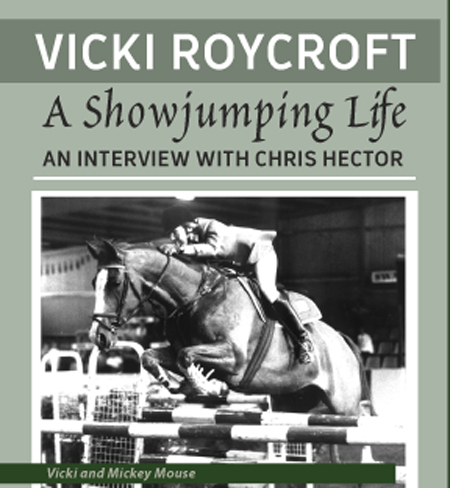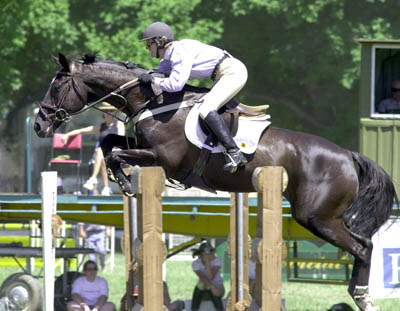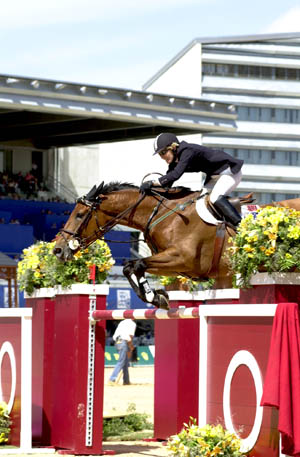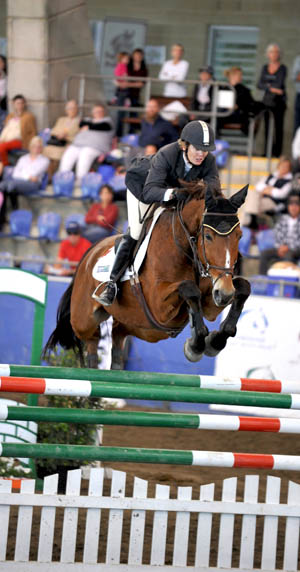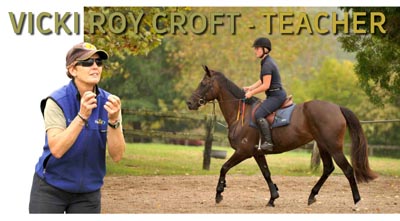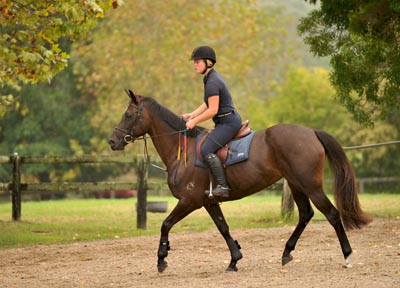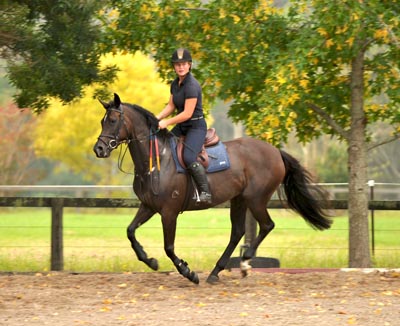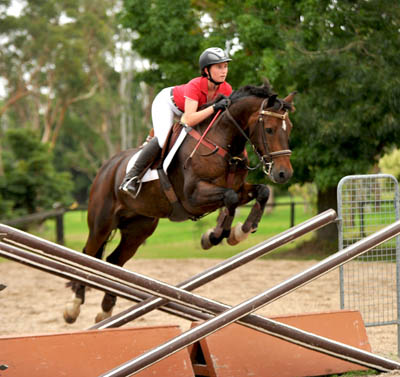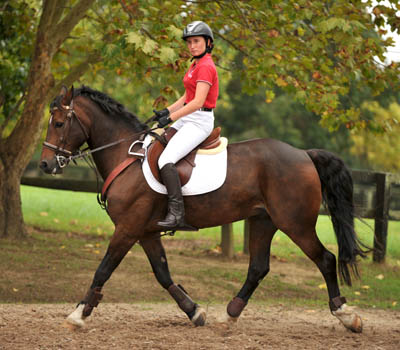Last month, we followed the story of Vicki’s showjumping career all the way to her historic victory with Apache at the Grand Prix of Rome, but after the triumph came sadness, Apache was sold, and Vicki was once more looking for a horse:
“There weren’t many horses available, and after I’d sold Apache I had a bit of cash. I was being sponsored by Ranvet and I wanted something to ride. Mickey Mouse was available. He wasn’t what I thought was the perfect horse. He was okay. Michelle Strapp did such a wonderful job on that horse, because he wasn’t the scopiest thing on the planet, but she had brought him along so carefully and trained him so well – I’m in awe of what a good trainer she is, because this horse, even though he was really a 1.40m horse, he thought he could jump 1.60m. No one had told him different. So for the time that I had him, he’d climb over 1.60m and he was very careful. He was a wonderful horse because Michelle had never pushed him, never scared him.”
“He has probably been one of my most successful horses with the least amount of talent. He took me to the 1988 Games, and he was a counting score in our Nations Cup team. In those times, they took five, and Stan Fear, the chef, wanted everyone to have a go, so he left me out of the individual competition.”
You made up for that two years later at the first WEG in Stockholm?
“He was green in Seoul, poor little guy it was tough on him. In Stockholm, he was okay in the lead ups, but when he finished up ninth there, that was a real shock; he was just in a good zone at Stockholm. He did climb over some fences. I think in the first round he kicked out at an oxer and kicked out nearly all the rails except the top rails. He just got better and better. It was a big open ring so I could get at fences, he could hunt down to them at three-quarter pace, and he was careful enough.”
Is that something about you as a rider – that you do seem to go that much better at the really big shows…?
“It’s such a privilege to ride into some of those big arenas, that’s what I really enjoyed – but I think quite a lot of riders get nervous and can’t perform to their best ability. At Aachen, or Stockholm, or Hickstead, any of those fabulous arenas, it is such a privilege to be there, it does lift you.”
But you must have a good head for competition?
“In those days, I’m sure it is not as good now.”
You don’t get nervous?
“Sure everyone gets nervous, of course you get nervous, but that’s what Wayne taught me to deal with very early and that is what he is very good at – a little like George in that respect – he can bring the best out in you. Wayne was always very good for my head, he would make me mentally very strong. He taught me that you make your nerves work for you, so that you learn to focus and challenge your energies into producing the best performance you can, rather than letting your nerves destroy you, which does happen with a lot of people. I wasn’t a very tough person mentally, he made me tougher. I’m eternally grateful for that, and for the attention to detail.”
The next major horse was Coalminer?
“He was a wonderful horse. He was originally produced in Western Australia, by Shaun Squire, and I think he won a World Cup on him… then Gavin Chester got the horse and won a World Cup with him. The horse was on the market and we bought him. He was wonderful, I think he might still hold the record for consecutive World Cups. He has probably been my most successful horse, just in the amount of things he has won. He won in Europe, he went to South America and won a car in a Grand Prix that Leopoldo (Palacios) built…”
Vicki and Coalminer
“He was very scopey, very good technique, careful enough and a good brain – he was trainable. This is where the flatwork was terribly important, because he had a canter that was twenty feet long and very strung out, like a camel. Riding him downhill felt dreadful, but once you learnt to compact his canter, he was unbelievable, because then he could do anything.”
He was straight Thoroughbred: that was back in the days when you used the word ‘dumb blood’ dismissively…
“I’d still love to get a Thoroughbred, but they are just not around. To find another Apache – my god! There are plenty of little scrawny hot things around but they don’t jump like him. Coalminer was a wonderful Thoroughbred, but at the end of the day, the Thoroughbreds just aren’t careful enough.”
When did you first start to get involved with Warmbloods?
“Luna Luna. After Coalminer, there was Liaisons that I bought from Gill Rolton, and that is how I got Errol (Premier des Hayettes) because I swapped him as part of the deal. Luna I bought as a five or six-year-old… but the thing about Warmbloods now is that they are seventy per cent Thoroughbred. The Europeans got smart with that, they still won’t tell you, but when you go to the Holstein Verband, there are six Thoroughbred stallions there. You really go for anything that jumps. Nothing else matters, not their colour – not even if they are coloured, like Visage, who I think is a wonderful jumper, he might have lacked what they call ‘the last scope’ but to me his attitude was so wonderful.”
Did you have to adjust much when you started to ride Luna?
“No, I still haven’t stopped learning, but I think the basic flat knowledge was always there. With Coalminer I had to do a whole lot with his flatwork and canter to make him a more competitive jumper – Gavin was such a genius that he could adjust to the horse, and with that horse, he’d just cut out strides all over the place, and it wasn’t a problem. I couldn’t do that, the horse had to be adjusted to my way of riding, but I think in the end, I made a better horse of him. The main problem with Luna was that she was just difficult. She was headstrong. When I first brought her out here, I had to fix her spookiness problems, I had to take her up the drive and ride her round the road. The first day, to get her out of the driveway – 150 metres long – took me, 40 minutes. She was very difficult, it wasn’t because she was a pig, she was genuinely frightened, she was quite a sensitive soul in this big, heavy body. She was a project, but a fabulous jumper and she ended up a great horse. I wish I could have kept her, but the finances were a bit tight.”
Luna Luna – the first Warmblood
“Now my horses are all Warmbloods, and the last crop I got from Europe. The bay one I bought is a lovely horse, he is like a Thoroughbred – Cachet by Canute. He’s only eight. Casino Royale, the little stallion of Robyn’s, that she bought as a three-year-old, George Morris thinks he’ll be a real 1.60m horse, and he is just delightful, I love him. He really didn’t fit that European system because he is a very careful, quality, sensitive horse and he needs an accurate ride. In Europe they have a bunch of riders and all of them are not necessarily great riders, that doesn’t suit some horses. The horse was genuinely scared when I started to ride him, now he is wonderful. He likes it out here in Australia. He likes his paddock.”
Kartoon de Breve
“The Kartoon horse, because my budget is limited, is a repair job but he is coming good. I’m quite happy with what I’ve got now.”
There was a time when George Morris stopped coming to Australia – but you’ve managed to get him coming regularly again, and that has made a huge difference…
“I’d asked him a few times but he was so busy, he still is very busy and unfortunately the only time of the year he can come out is that hot time around January when a lot of people don’t have horses in work, but okay, you get him when you can. I’ve got to again give credit to Michelle Strapp because she’d written to him asking him to come out – he spoke to me somewhere, and said, Michelle wrote, I can come out, but she hasn’t written back. I said, come out, I’ll arrange something, just come out. I’m very careful now because for any of the coaches who come here, it’s a bloody long way, for him it is 17 hours sitting on a plane. I try to make it as good as possible for him when he comes out. I send out emails to try and make sure the students are well prepared for him – speak when you are spoken to, look spotless, make sure your gear is good. He loves teaching in Wayne’s paddock, he loves that grass area, so he is quite happy to come out because he knows exactly what he is in for. He stays in a little motel down the road, and the gym is about 100 metres away. He enjoyed doing the clinic in Victoria this time… so next year, he’ll do three in NSW and one in Victoria again.”
And you, you’re not slowing down?
“Yeah, I can’t ride anywhere near as many as I used to. I’d ride seven or eight in a day, now four or five pulls me up.”
Does the fire still burn at fiercely?
“I’d need a really nice horse to make me excited. I’m cautiously excited about Cachet and Casino Royale… It depends on the horses. I could be like Laurie Lever, and if you found an Ashleigh Drossel Dan, then you would grab it with both hands. Before I could probably get onto teams with a fair range of horses, I don’t think that is the case now, I’m not that gifted or driven, but if I got a really nice horse, I’d love to do it again.”
It’s great to watch Vicki at work with her students, it is obvious that she enjoys helping them, and they respond to her. In this session, the horse has a truly curious history:
“John Singleton gave me this mare. She is out of Belle de Jour, a really famous racehorse. They couldn’t get the mare to breed so they tried AI, this is the result and of course she couldn’t be registered as a Thoroughbred. Singo swears this is a clone of Belle de Jour… When I had my eye operation, he said to me, I know you are not into flowers and things, so I’ll give you a horse, the only thing is you can’t sell it. I thought, that’s very sweet of you but my business depends on being able to buy and sell horses, then I thought it might be nice to get him involved and interested in the sport.”
“She was unbroken, and I said that’s a bit useless to me right now, so he got her broken in and then I put her in foal to Errol last year, and she has a lovely Errol filly – except the mare wouldn’t accept it. The kids came running ‘Belle’s had a foal’, so I went out to see, and here is Belle down one end of the paddock and down the other end is the foal with a mare that already had a foal. We got Belle and the mare in and tried to get her to accept the foal, which she wouldn’t, l said to Brett the Vet, the other mare seems to be accepting the foal, is it a problem if I put them out together? Up to you. So I put them out, Belle went off to eat grass, and the other mare came galloping down the paddock and the foal straight away started to feed from her. The foal she had was three months old, it was her first foal, and she obviously thought, I like this, you get a brand new baby every three months.”
“Sometimes I think she is by an Arab… but no-one knows. Gerry Rose who did all the AI work wouldn’t tell Singleton what she was by, John reckons he was experimenting and made a clone… Johnny Walker the vet was up here one day and he knew Belle de Jour. I didn’t tell him anything I just said look at this one – bloody hell, he said, it is a dead ringer for Belle de Jour. Belle was three when we started to work her, she’s five now. She’s done Jump Club.”
“I’d like to think this mare will jump C and D grades, but I don’t know about much more. She is cute as.”
The student has a somewhat more conventional history, Amanda Ingren-Ohlson is from Sweden and grabbing the opportunity to ride and learn in Australia:
Amanda Ingren-Ohlsonwho has just turned twenty, is enjoying her time in Australia:
“I am from down south of Sweden, near Malmo. I started at a riding school when I was about six, and rode until I was ten. Then I had two years away from riding, actually, I got scared. There was a horse that reared, so I stopped for two years. I have been riding since.”
“I finished high school last year, so this is my free year. I wanted to do something different, and something with horses, my dad got a tip from a lady he knows, and she said contact Vicki Roycroft because she is brilliant. I did and she answered and I am here.”
Is it very different to what you are used to in Sweden?
“Pretty different, especially the riding style. At the riding school, they taught us the German style, that is more sitting deep down in the saddle compared to the American style which is a bit more two point. I like the style here at Vicki’s, it’s really good.”
It would seem that the time at Vicki’s might have put an end to the higher education plans:
“I was planning to go to university next year, but I don’t really know because when I get back home, I will probably want to start competing my horse again and I’ll probably work and compete for another year, but I am going to uni at some stage…”
Vicki is pleased with the way the new combination is shaping up:
“Belle is a good horse for Amanda to ride while she is here. Amanda was typical of the German style, a seat rider, a hand rider, and it was a revelation for her to come across our George Morris-based style.”
And of course, any good jumping lesson starts with work on the flat and once again it is about creating a contact that at the same time lets the horse stretch and use its body:
“Do some transitions, trot walk, walk trot, this is better. Now Amanda is starting to understand about the upper body and the balancing leg, to create that downward transition. Think more inside leg to outside rein even if you turn it into a bit of a leg yield. Make a smaller circle and push her into your outside rein, keep your outside rein, keep the neck straight. Keep at it until you start to feel her chewing the bit, she has to take the contact and chew the bit a little better. Go on to the larger circle again but don’t throw the rein away, keep a little feel, ride her onto the circle, don’t just chuck the rein at her, change your rein through the circle, that’s better… when she comes lighter, then more leg to your hand.”
Time to move on to the canter work:
“Let’s canter the pole. Good girl, that’s the lovely thing about poles and cavallettis, the riders can practice riding lines, riding distances, without scaring the horses or getting them sick of jumping. Remember to keep your leg on and follow… it’s your decision there, it’s either the direct seven or the stay out eight, let’s stick with the seven for the moment, keep forward and even, think of your outside aids, but your position is heaps better.”
“1 2 3 4 5 6 7 – good girl. Great.”
But there were still jumping questions to resolve:
“Push on. When you don’t have a great distance at the first of a related fence line, because you know it’s five strides and you get there a little dead and deep, then you are going to have to make up ground – that’s not rocket science, and it’s not something that you should have to think about, you have to develop it to be your instinct. That’s a related distance, so how you ride the first is going to affect how the second one is going to come up. It you get dead and deep and messy, you’ve got to do something, you’ve got to add a stride or make up the ground.”
“That was pretty good because you are both green, so sometimes when you were doing the right thing, she was reacting a little bit hollow. Amanda still has to learn about getting the horses through, getting them more round, getting them to stretch. The fence get hollow at times right now. Make sure she’s not sitting behind your hand so much, because then she gets to the fence and she is behind your leg and behind your hand and then she gets that praying mantis stuff, now you are not getting in the way, you are staying with her.”
Time to call it a day:
“Just lengthen your rein, give her a pat. You can relax. It’s getting better, it is just a matter of practice. Do the cavallettis, do the poles, get more comfortable with your eye so you are able to find a distance. You’ve got to be able to get her more connected, so that you’ve got more adjustability in the stride. You’ve got to have enough weight in your hands so that she is taking you forward confidently, so that she wants to go forward. It must be, the horse thinks forward and straight until you tell it otherwise. I get on most people’s horses, and the first thing I do is make them go forward. It drives me nuts; I want to be carried forward by the horse, not have to chase it forward. I want the horse to go somewhere. Your position is much better, you are much more with the horse, you are not getting in the way – that is necessary on a horse like this that is green, especially as she is quite a careful little thing.”
The next combination is really quite extraordinary – 14-year-old Stephanie McKillop riding a Welsh cob, Alcheringa Tradition.
According to Stephanie’s mother, Penny:
“We didn’t buy him as a jumping pony, but fortunately for us, he has turned out a ripper. The Welsh Cobs are apparently very talented jumpers but unfortunately not used enough. They are very powerful, very springy.”
Vicki shares her view:
“This guy is amazing, he’s nearly got the stride of a horse and he has got quite a lot of power. I can see him doing Mini Prix, I don’t know if he can do much more than that…”
No World Cup starts…
“It’s not totally out of the question.”
Vicki is happy with the progress:
“He’s come up pretty quick, he is C grade now. I’ve been working with him for 18 months, two years, and now with Steph we are moving into a few of the finer points, instead of just getting from one side to the other.”
Major training issues with him?
“He is a bit of a feisty little pony, sometimes he has his own opinion, not that he doesn’t want to jump, he is as brave as, sometimes too brave. The first thing I’ve been working on is Steph’s warm up techniques, so that they went into the ring focusing on fences. To Steph’s credit she has been great to work with, she is a little younger than the students I usually like to take on, but she has a good brain and works hard. As I said, one of the problems is that sometimes the pony is a little too brave and we have to work on the art of riding very careful fences. It is more the fine-tuning because they are very confident and competent around metre twenty tracks, which is great for a pony of this size. He is just a little gun this horse.”
You said you had to work on warm-up technique…
“She didn’t really has a clue. The first time I went to a show with her, she was a bit crazy and would just jump anything from anywhere, and I said ‘you’ve got to have a program for a warm up, so you go into the ring focused on the top rail’ – she had to be able to get the horse focused on what they were doing. This pony is careful enough, just a little front end rub is enough to get him back being careful, but sometimes he is a little too brave and wants to take them on, he is amazing.”
“The last lesson Steph had with me, I had a little sit on him and it was like the lesson with Ben Blay (see last month); getting the horse to wait for the distance and sit on his hocks, and then holy hell, he jumps the top of the wings. He is quite remarkable with his jump and I don’t want to rush this kid too much, but she is great, she does cope with the more technical elements of the sport. She does get into a little trouble with her hands, she can get jammy. You can see the pony goes in a Spanish snaffle or Kimberwick, which is against my general philosophy, but he is very comfortable in it, so why try and fix what ain’t broke. The pony gives you a good feel in that bit so we stick with it.”
“She is a nice little rider, there is not a lot of work to be done. Okay, with this one she rides without spurs so you have to look that she doesn’t get her heels up – trying to use her heels. He does get a little hot and she gets worried about that, but I would like to get her to use even a little spur because there is nothing better to train a lower leg than a little spur. It trains your lower leg to be still.”
“You’ve got to remember you are on an animal, not a machine, so he is going to think, he is not just going to be a robot, he is going to be thinking about things like the home corner, so anticipate that – that’s it, two reins, two legs. ”
Vicki is an exacting teacher, and the stirrups are put away for a while:
“On the circle now in slow sitting trot and think about keeping the line of his body on the line of the circle, watch that he doesn’t bulge his left shoulder. Good you have improved your downward transitions because you are using your upper body mpre. You’ve got to learn about combining your aids, combining your leg and your hand and your upper body.”
“Knees and heels down, lower leg back, cuddle him with your lower leg…”
“It is all about teaching Steph to become the rider not the passenger, so it becomes a comfortable relationship – okay she is the senior partner but he is accepting of the whole thing. You develop the attitude in the horse – what would you like me to do now?”
Steph doesn’t mind that her teacher is tough:
“Vicki is great. I love having lessons with her. I can tell her any problem, and she’ll help me with it, she really understands my horse and knows what is good for him.”
She is tough too, she makes you ride without your stirrups…
“She says it is the best thing for your riding. It’s good though, she is tough but it makes you a better rider for it.”
The work is getting more complicated:
“Okay pop into canter, do the pole, then the pole, then the cavalletti. Keep him straight, keep your outside rein a little better. Pole to cavalletti, seven or eight, it is sometimes better to do the seven, that was the eight.”
“Do the two cavallettis, I want you to do a couple of fives, then I want you to do a four and then a six. That was the five, do another five. Half halt and six, very good. Now the four, that’s it, get him going on the long side, look early, get your pace, very good. Okay come back to a five now.”
“That’s quite a nice exercise for the young ones and the green ones to learn about the different pace and the balance, and learn to count their strides. He has a good canter and now he is up in metre twenty, metre thirty classes, he has had to learn to adjust his stride. And for a 14-year-old, this girl is really quite a rider.”
And the teacher, quite a teacher.



